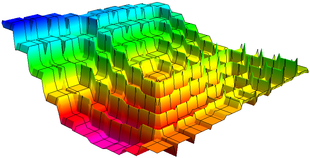|
|
| Line 9: |
Line 9: |
|
[http://katlas.math.toronto.edu/drorbn/index.php?title=Image:327-notes_for_120610.pdf Lecture Notes] |
|
[http://katlas.math.toronto.edu/drorbn/index.php?title=Image:327-notes_for_120610.pdf Lecture Notes] |
|
|
|
|
|
⚫ |
*'''Question.''' The fact that the metric space of real-valued functions on the unit interval with uniform metric is complete uses the fact that [0,1] is compact right? If the function space is defined on a non-compact topological space is that necessarily complete?... -Kai [[User:Xwbdsb|Xwbdsb]] 00:01, 20 December 2010 (EST) |
|
*Question. |
|
|
|
** No, the compactness of <math>[0,1]</math> is not used. As we said in class, if <math>(f_n)</math> is Cauchy in the uniform metric, then for any <math>x</math>, the sequence <math>(f_n(x))</math> is Cauchy in <math>{\mathbb R}</math>, so it has a limit. Call that limit <math>f(x)</math>; it is not hard to show that <math>f</math> is continuous and that <math>f_n\to f</math>. Theorem 43.6 in Munkres is a slight generalization of this. [[User:Drorbn|Drorbn]] 07:12, 20 December 2010 (EST) |
| ⚫ |
The fact that the metric space of real-valued functions on the unit interval with uniform metric is complete uses the fact that [0,1] is compact right? If the function space is defined on a non-compact topological space is that necessarily complete?... |
|
|
-Kai[[User:Xwbdsb|Xwbdsb]] 00:01, 20 December 2010 (EST) |
|
Revision as of 08:12, 20 December 2010
| Additions to the MAT 327 web site no longer count towards good deed points
|
| #
|
Week of...
|
Notes and Links
|
| 1
|
Sep 13
|
About This Class, Monday - Continuity and open sets, Thursday - topologies, continuity, bases.
|
| 2
|
Sep 20
|
Monday - More on bases, Thursdsay - Products, Subspaces, Closed sets, HW1, HW1 Solutions
|
| 3
|
Sep 27
|
Monday - the Cantor set, closures, Thursday, Class Photo, HW2, HW2 Solutions
|
| 4
|
Oct 4
|
Monday - the axiom of choice and infinite product spaces, Thursday - the box and the product topologies, metric spaces, HW3, HW3 Solutions
|
| 5
|
Oct 11
|
Monday is Thanksgiving. Thursday - metric spaces, sequencial closures, various products. Final exam's date announced on Friday.
|
| 6
|
Oct 18
|
Monday - connectedness in  , HW4, HW4 Solutions, Thursday - connectedness, path-connectedness and products , HW4, HW4 Solutions, Thursday - connectedness, path-connectedness and products
|
| 7
|
Oct 25
|
Monday - Compactness of ![{\displaystyle [0,1]}](https://wikimedia.org/api/rest_v1/media/math/render/svg/738f7d23bb2d9642bab520020873cccbef49768d) , Term Test on Thursday, TT Solutions , Term Test on Thursday, TT Solutions
|
| 8
|
Nov 1
|
Monday - compact is closed and bounded, maximal values, HW5, HW5 Solutions, Wednesday was the last date to drop this course, Thursday - compactness of products and in metric spaces, the FIP
|
| 9
|
Nov 8
|
Monday-Tuesday is Fall Break, Thursday - Tychonoff and a taste of Stone-Cech, HW6, HW6 Solutions
|
| 10
|
Nov 15
|
Monday - generalized limits, Thursday - Normal spaces and Urysohn's lemma, HW7, HW7 Solutions
|
| 11
|
Nov 22
|
Monday -  and and  , Thursday - Tietze's theorem , Thursday - Tietze's theorem
|
| 12
|
Nov 29
|
Monday - compactness in metric spaces, HW8, HW8 Solutions, Thursday - completeness and compactness
|
| 13
|
Dec 6
|
Monday - Baire spaces and no-where differentiable functions, Wednesday - Hilbert's 13th problem; also see December 2010 Schedule
|
| R
|
Dec 13
|
See December 2010 Schedule
|
| F
|
Dec 20
|
Final exam, Monday December 20, 2PM-5PM, at BR200
|
| Register of Good Deeds
|

Add your name / see who's in!
|

See Hilbert's 13th
|
|
See some blackboard shots at BBS/10_327-101206-142909.jpg.
Video:  Topology-101206
Topology-101206
|
|
Dror's notes above / Student's notes below
|
|
Lecture Notes
- Question. The fact that the metric space of real-valued functions on the unit interval with uniform metric is complete uses the fact that [0,1] is compact right? If the function space is defined on a non-compact topological space is that necessarily complete?... -Kai Xwbdsb 00:01, 20 December 2010 (EST)
- No, the compactness of
![{\displaystyle [0,1]}](https://wikimedia.org/api/rest_v1/media/math/render/svg/738f7d23bb2d9642bab520020873cccbef49768d) is not used. As we said in class, if
is not used. As we said in class, if  is Cauchy in the uniform metric, then for any
is Cauchy in the uniform metric, then for any  , the sequence
, the sequence  is Cauchy in
is Cauchy in  , so it has a limit. Call that limit
, so it has a limit. Call that limit  ; it is not hard to show that
; it is not hard to show that  is continuous and that
is continuous and that  . Theorem 43.6 in Munkres is a slight generalization of this. Drorbn 07:12, 20 December 2010 (EST)
. Theorem 43.6 in Munkres is a slight generalization of this. Drorbn 07:12, 20 December 2010 (EST)
![]() Topology-101206
Topology-101206

![{\displaystyle [0,1]}](https://wikimedia.org/api/rest_v1/media/math/render/svg/738f7d23bb2d9642bab520020873cccbef49768d)









